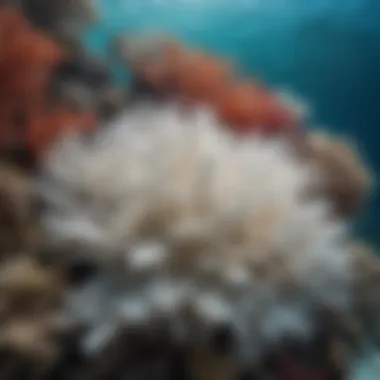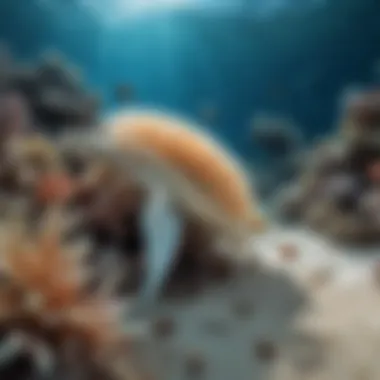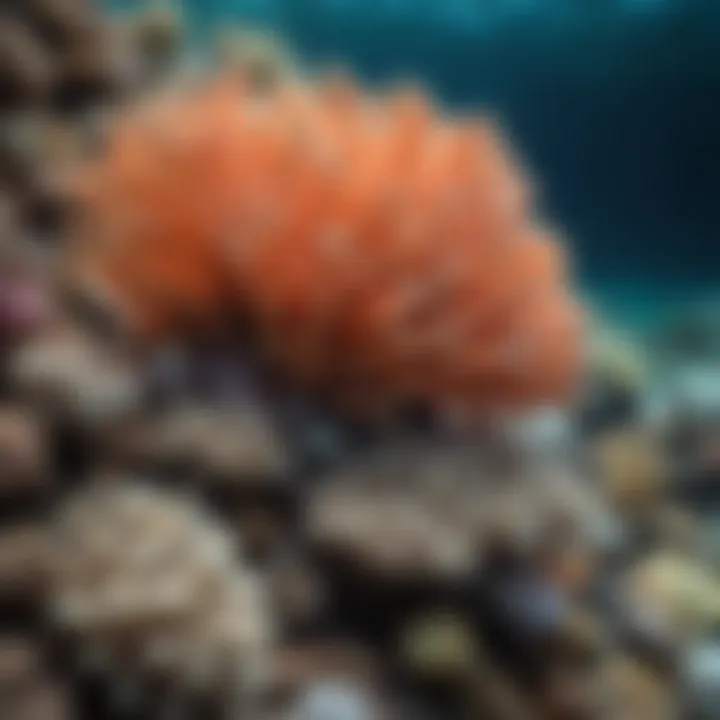Mass Bleaching in the Great Barrier Reef Explained


Intro
The plight of the Great Barrier Reef serves as a stark reminder of the fragility of our marine ecosystems. Mass bleaching events have become alarmingly frequent, threatening the very fabric of this UNESCO World Heritage Site. This article examines the intricate web of causes, effects, and potential future scenarios concerning mass bleaching, providing an informative guide to understanding this ecological crisis.
As global temperatures rise, the coral reefs, which are sensitive indicators of environmental health, experience stress that leads to bleaching. Factors driving these changes include climate change, pollution, and unsustainable human activities. In light of this, it is essential to delve into the current research surrounding the Great Barrier Reef to garner insights on both the immediate and long-term repercussions.
Through this exploration, we will emphasize the findings from recent studies and conservation efforts, thus highlighting the crucial role of informed interventions to reverse damage. The facts surrounding the Great Barrier Reef not only engage scientific discourse but also reveal extensive implications for biodiversity and human interaction with natural resources.
Understanding this crisis involves examining the data, assessing what has been learned, and thinking critically about the path forward. Let us begin by outlining the research conducted on mass bleaching within one of the planet's most biodiverse ecosystems.
Preface to Mass Bleaching
Mass bleaching poses a significant threat to coral reefs, particularly in the Great Barrier Reef. Understanding this phenomenon is crucial not only for biodiversity but also for our global ecosystem. It affects marine life, influences tourism, and impacts local economies. While many may be aware of coral bleaching, a deeper knowledge reveals its causes, effects, and viable solutions. This section serves to establish a foundation for readers to appreciate the urgency of the topic.
Definition and Overview
Mass bleaching refers to the process by which corals lose their symbiotic algae, known as zooxanthellae. This relationship is integral, as these algae provide corals with the nutrients needed for survival through photosynthesis. When corals are stressed, often due to rising water temperatures, they expel these algae, leading to a stark loss of color - hence, the term "bleaching". If conditions do not improve, the coral can ultimately die.
The indicators of mass bleaching events can range from temperature increases to changes in water quality. Specifically, a sustained increase in sea temperature by just one degree Celsius over a prolonged period can trigger bleaching. The implications are severe, affecting not just the health of corals but also the diverse marine ecosystems that depend on them.
Historical Context
Historically, mass bleaching events have been documented since the 1980s, with notable increases in frequency and intensity. One significant event occurred in 1998, when global ocean temperatures peaked due to El Niño, causing coral mortality across the world. More recently, the Great Barrier Reef experienced extensive bleaching in 2016 and again in 2017, and these events serve as stark reminders of the fragility of these ecosystems.
Over the past few decades, scientific studies have illustrated the correlation between climate change and coral reef health. The rising global temperatures, associated with greenhouse gas emissions, have created an environment less hospitable to corals. Furthermore, pollution from coastal development has exacerbated the issue. The historical perspective emphasizes the unpredictability of coral reefs under climate stress, underscoring the need for proactive conservation strategies to prevent further degradation.
The Great Barrier Reef: An Ecological Treasure
The Great Barrier Reef is not just a beautiful picture of nature; it is a vital ecological treasure. Stretching over 2,300 kilometers along the coast of Queensland, Australia, it represents the largest coral reef system in the world. It sustains a complex web of marine life, supports diverse ecosystems, and serves crucial services for human populations, from tourism to coastal protection.
The reef plays a significant role in global biodiversity. It houses thousands of species, including many that are endemic. These thriving communities of organisms interact in intricate ways, forming a vibrant ecological network that contributes significantly to the planet's health.
Additionally, the Great Barrier Reef is essential for scientific research. It offers a natural laboratory for studying marine biology, evolution, and climate change impacts. Researchers and students from across the globe flock to this area to understand better how ecosystems function and react to external pressures. The knowledge garnered here is indispensable in framing conservation strategies not only for the reef but also for other vulnerable ecosystems worldwide.
Dr. Ove Hoegh-Guldberg, a leading marine scientist, noted:
"The Great Barrier Reef is a natural wonder, teeming with life, yet it is more than just a beautiful scene; it is a barometer for our planet’s health."
This treasure is also pivotal in providing economic benefits. The tourism industry surrounding the reef brings billions to the Australian economy and creates countless jobs. Engaging with its natural wonders, visitors contribute to conservation efforts indirectly through their presence and financial support. However, the challenge remains to balance economic growth with the preservation of this delicate habitat.
Ultimately, the significance of the Great Barrier Reef extends beyond mere aesthetics or economics. It represents a crucial component of marine biodiversity and an invaluable resource for research and education. Protecting it must be a priority, as it faces numerous threats from climate change and human activities.
Mechanisms of Coral Bleaching
Understanding the mechanisms of coral bleaching is essential for comprehending the current crisis facing the Great Barrier Reef. This section addresses how delicate processes within coral ecosystems become disrupted, resulting in widespread bleaching. It delves into crucial biological relationships and cellular responses, providing insight into why coral reefs, despite being resilient creatures, are increasingly vulnerable to changing environmental conditions.
Symbiotic Relationships
Coral reefs are formed through the unique partnership between coral polyps and a group of microscopic algae known as zooxanthellae. This relationship is central to the health of reefs. Zooxanthellae live within the tissues of coral and provide essential nutrients through photosynthesis. In return, corals offer the algae a protected environment and access to sunlight.
When ocean temperatures rise, even slightly, this partnership is compromised. Corals may expel their zooxanthellae, leading to a loss of color and, consequently, the characteristic beauty of coral reefs. This expulsion leads to nutritional stress for corals, making them susceptible to disease and mortality. The intricate dynamics of this symbiotic relationship indicate that maintaining stable environmental conditions is crucial for coral survival.
Temperature Stress and Cellular Response
Corals are ectothermic organisms, meaning their body temperatures are influenced by their surrounding environment. When water temperatures exceed the optimal range for corals, they experience physiological stress. Elevated temperatures can disrupt the delicate balance of metabolic processes in coral cells. They eventually induce harmful cellular responses.
Under temperature stress, corals increase the production of stress proteins, such as heat shock proteins, which attempt to counteract damage. However, the effectiveness of these proteins diminishes when temperatures are excessively high. Prolonged exposure can lead to cellular dysfunction and apoptosis, or programmed cell death.


"Coral bleaching serves as a warning signal, reflecting broader environmental changes that threaten marine biodiversity."
In summary, the study of mechanisms of coral bleaching provides vital insights into how coral reefs respond to environmental stressors. By understanding the symbiotic relationships and the implications of temperature stress, researchers can develop more effective conservation strategies aimed at protecting these essential ecosystems.
Causes of Mass Bleaching Events
Understanding the causes of mass bleaching events is crucial for appreciating the broader ecological implications for the Great Barrier Reef. It is not just about identifying problems but also about tackling them effectively. The interface between climate change and the marine environment is complex, involving multiple factors that contribute to coral stress, degradation, and eventual mortality. Recognizing these causes can help inform conservation strategies and guide policy responses aimed at mitigating the adverse effects on this vital ecosystem.
Climate Change and Rising Sea Temperatures
One of the primary drivers of mass bleaching is climate change, particularly the rise in sea temperatures. The recorded increase in global temperature has led to elevated sea surface temperatures, which significantly affect corals. Corals thrive within a narrow temperature range, and even a slight increase can induce bleaching. When seawater warms, corals expel the symbiotic algae, known as zooxanthellae, that live within their tissues. This process leads to a loss of color and a decrease in the energy sources that corals rely on for growth and survival. The phenomenon has been observed during prolonged heatwaves, with the 2016 bleaching event being a stark example. This heat stress can cause widespread coral mortality if temperatures remain high for extended periods.
Ocean Acidification
Another pressing concern is ocean acidification, a direct consequence of increased carbon dioxide levels in the atmosphere. As CO2 is absorbed by oceans, the water becomes more acidic, affecting the calcium carbonate structures that corals need to build their skeletons. Such conditions can weaken coral health and make them more susceptible to bleaching. Moreover, the reduced availability of calcium carbonate undermines coral resilience to temperature changes, making recovery after a bleaching event more difficult.
Pollution and Coastal Development
Pollution—stemming from agricultural runoff, sewage discharge, and plastic waste—contributes to the degradation of water quality in coastal regions. Nutrient loading from fertilizers can lead to algal blooms that further reduce oxygen levels in the water, harming corals. Coastal development that disrupts habitats can exacerbate the problem. Structures like ports and coastal resorts can alter water flow and sedimentation patterns, further stressing these fragile ecosystems. Each of these aspects combines to create a hostile environment for corals, increasing their likelihood of bleaching and reducing their chances of recovery.
The Impact of Mass Bleaching on Marine Ecosystems
The phenomenon of mass bleaching has profound implications for marine ecosystems, especially within the unique context of the Great Barrier Reef. It highlights a critical environmental issue, touching upon ecological balance and biodiversity. Understanding the impact of these bleaching events is crucial, as they serve as indicators of broader environmental changes and challenges. Both students and researchers must grasp the significance of these phenomena to advocate effectively for conservation efforts.
Loss of Biodiversity
Mass bleaching leads directly to a loss of biodiversity, which is alarming given the rich variety of marine life associated with coral reefs. When coral reefs experience significant stress, they expel the symbiotic algae known as zooxanthellae, resulting in a stark loss of color and vitality. Without these algae, corals struggle to obtain the necessary nutrients to thrive. This adversely affects not only the coral itself but also countless species that depend on coral reefs for habitat and food.Regrettably, this ongoing trend could result in diminished populations of fish and other marine organisms that rely on healthy reefs.
Research demonstrates that up to 50% of the reef's species may be threatened during severe bleaching events. Loss of biodiversity can create a cascading effect throughout the ecosystem, resulting in decreased productivity and long-term ecological imbalances. Furthermore, certain species that play crucial roles in maintaining the structure and function of reef ecosystems may be lost, leading to further degradation.
Alterations in Food Webs
The alterations in food webs represent another significant consequence of mass bleaching events. Coral reefs are foundational species in their ecosystems, supporting complex relationships among various organisms. When these reefs are damaged, the food web is disrupted. Herbivorous fish, for example, rely on live corals for sustenance. A decline in coral health forces these fish to seek alternative food sources, often leading to competition and resource depletion.
As the food web shifts, predators that depend on these herbivores may also face food shortages, creating an imbalance that can affect entire communities. This instability is particularly troubling for apex predators, which play essential roles in maintaining the health of marine ecosystems. The intricacies of these relationships suggest a fragile interconnectedness that is easily destabilized by stressors like mass bleaching.
"The interdependence of species in coral reef ecosystems emphasizes the urgency of addressing the causes of mass bleaching."
To summarize, the impact of mass bleaching on marine ecosystems cannot be overstated. The loss of biodiversity and the alterations in food webs serve as critical reminders of the importance of coral reefs in global marine health. Addressing these challenges is not only an ecological imperative but also a societal responsibility as individuals and communities strive to protect such vital ecosystems.
Case Studies of Bleaching Events
The examination of case studies related to bleaching events is essential for understanding how mass bleaching impacts the Great Barrier Reef. Not only do these instances provide concrete examples of the phenomenon, but they also highlight the various contributing factors and responses to such ecological crises. By investigating specific events, researchers obtain data that aids in discerning patterns and making predictions about future occurrences. Case studies also serve to raise awareness about the urgency of conservation efforts.
Bleaching Event
In 2016, a significant bleaching event ravaged the Great Barrier Reef. Reports indicated that approximately one-third of the reef’s corals bleached over a period of just a few months. The severity of this event was attributed mainly to elevated sea temperatures caused by climate change. During this period, water temperatures rose to uncomfortable levels for coral, pushing them to expel the algae known as zooxanthellae that are essential for their survival.
The 2016 event differed from previous occurrences in scale and impact. While smaller bleaching events had been documented before, the intensity and widespread nature of this incident shocked scientists and environmentalists alike. Long-term monitoring showed long-lasting effects on coral health, including decreased reproductive success and slower recovery rates.
"The 2016 bleaching event forced us to reevaluate how we understand coral resilience and the need for proactive measures against climate threats."
- Marine Biologist, Dr. Rachael S. Lee
The significance of this event lies in the lessons learned about coral ecology and the urgent need for more comprehensive conservation efforts. As scientists analyze the remaining corals, they focus on potential adaptive strategies these corals might employ to survive rising temperatures in the future.
Recent Developments in


The year 2020 marked another critical moment for the Great Barrier Reef. Several reports indicated that there were significant bleaching events once again, although less severe than that of 2016. The combination of sustained high temperatures and additional stress factors, such as pollution, contributed to the uptick in bleaching incidents.
Key findings from studies conducted in 2020 showed that certain areas of the reef were hit harder than others. The northern and central regions exhibited more extensive bleaching. Scientists noted a trend of repeated bleaching, which raises questions about long-term coral resilience. Without significant improvement in environmental conditions, these reefs may not have the capacity to recover fully.
Furthermore, research indicated that some coral species displayed signs of resilience. Certain types were better able to withstand high temperatures, potentially due to genetic adaptations. The ongoing research into these resilient corals is crucial for developing strategies aimed at mitigating future bleaching events.
Recognizing these trends informs not only researchers but also policymakers and conservationists, who must implement more effective measures to protect the reef and ensure its survival against climate change.
Research on Coral Resilience
Research on coral resilience is essential for understanding how corals can withstand stressors leading to bleaching. The impacts of climate change on marine environments have highlighted the urgent need to study coral adaptations. Corals, as symbiotic organisms, are made up of polyps that house algae known as zooxanthellae. This relationship is vital for their health and energy. Understanding resilience helps in developing strategies to protect these ecosystems.
Genetic Adaptations
Coral species show a remarkable ability to adapt genetically to changing environments. Studies indicate that some corals possess genes allowing them to tolerate higher water temperatures. For instance, scientists have been analyzing the genomes of various coral species to pinpoint these resilient traits. Genetic adaptations can greatly enhance the survivability of corals in warmer conditions. Research often focuses on:
- Identifying specific genes responsible for thermal tolerance.
- Understanding the role of symbiotic algae and how they adapt alongside corals.
- Exploring how these adaptations can be enhanced through selective breeding.
The implications of these findings are significant for conservation efforts. By focusing on genetically resilient species, it may be possible to bolster the overall health and stability of coral reefs.
Adaptive Management Strategies
Adaptive management strategies are crucial in the ongoing response to mass bleaching. These strategies aim to mitigate stressors affecting coral health while promoting resilience. They involve a systematic process of management that is flexible and responsive to new information. Key strategies include:
- Monitoring Coral Conditions: Regular assessments of water quality and coral health can inform timely interventions.
- Restoration Projects: Engaging in coral transplantation and other restoration methods can help re-establish healthy ecosystems.
- Community Engagement and Education: Involving local communities in conservation efforts fosters stewardship and increases awareness of reef health.
Adaptive management underscores the need for collaboration among scientists, policymakers, and local stakeholders. Implementing these strategies can aid in creating a more resilient marine environment that can better withstand future disturbances.
The survival of coral reefs largely depends on our understanding of their resilience and the timely execution of adaptive management strategies.
Conservation Efforts and Policy Responses
Conservation efforts and policy responses play a critical role in addressing the challenges posed by mass bleaching events in the Great Barrier Reef. Recognizing the integral connection between marine ecosystems and human activities, policymakers and conservationists are increasingly advocating for targeted actions. These initiatives aim not only to mitigate damages but also to promote resilience amongst coral populations and associated marine life.
Local and Regional Conservation Initiatives
Local and regional conservation initiatives are important for preserving the Great Barrier Reef. Many of these programs focus on direct action, engaging communities to recognize their responsibility in protecting this essential ecosystem. For instance, the Great Barrier Reef Marine Park Authority (GBRMPA) coordinates efforts to manage the reef sustainably. Measures include:
- Implementing zoning plans that restrict damaging activities such as overfishing and boating in sensitive areas.
- Promoting sustainable tourism practices to minimize impact.
- Collaborating with Indigenous communities to incorporate traditional ecological knowledge in conservation strategies.
These initiatives often involve community education programs that raise awareness of the reef's ecological significance and stress the importance of individual actions. Engaging local volunteers for activities such as reef clean-ups helps foster a sense of stewardship among residents.
International Policy Frameworks
In the broader context, international policy frameworks are also crucial for managing threats to the Great Barrier Reef. Agreements such as the Paris Agreement set targets for emissions reductions globally, influencing national policies that protect marine environments. These frameworks help ensure:
- Climate action aligns with marine conservation goals.
- Collaborative research efforts across borders to monitor coral health and bleaching events.
- Funding for conservation projects aimed at increasing coral resilience and biodiversity.
International entities, such as the United Nations Educational, Scientific and Cultural Organization (UNESCO), have recognized the importance of these frameworks. They provide guidelines for member nations to develop effective conservation programs, encouraging cross-border cooperation.
"The marine ecosystems need our urgent attention, and collaborative action at all levels is vital for their survival."
The interplay between local efforts and international policies offers a multifaceted approach to addressing the challenges of mass bleaching. By strengthening both levels of conservation action, it becomes possible to protect the Great Barrier Reef from further degradation and promote its long-term resilience.
The Role of Research Institutions
The study of coral bleaching, especially mass bleaching events affecting the Great Barrier Reef, requires significant input from research institutions. These institutions act as hubs for knowledge creation, data analysis, and policy development. Understanding the dynamics of coral ecosystems and the threats they face depends heavily on funding, expertise, and long-term commitment from these organizations.


Research institutions provide essential resources to investigate the various aspects of coral biology, ecology, and the external pressures leading to bleaching. They contribute to our knowledge by conducting field studies, laboratory experiments, and extensive data collection. This, in turn, helps in developing predictive models for future events, allowing for better preparation and response strategies.
In addition, they serve a dual role of educating the public and informing policy makers. Current issues regarding climate change and its impact on marine ecosystems must be communicated effectively to create a sense of urgency and promote action. Research findings from established institutions give credibility to these messages, supporting conservation efforts and policies at various levels.
University Contributions
Universities worldwide take part in foundational research on the Great Barrier Reef. They are at the forefront of marine studies and deploy teams of experts to gather data and engage in innovative research. Collaborations between universities and local communities can yield insights into the health of coral reefs.
For instance, universities like James Cook University and the University of Queensland have dedicated programs to study marine and environmental science. They drive initiatives that not only yield academic papers but also practical conservation strategies. These institutions actively involve students in research, fostering a new generation of marine scientists who will continue the fight against coral bleaching.
Collaboration Across Disciplines
Effective solutions to tackle coral bleaching do not emerge from a single discipline. Research institutions excel at fostering interdisciplinary collaboration. By bringing together marine biologists, ecologists, climatologists, and policy experts, these institutions can address the multifaceted nature of coral bleaching.
Through such collaboration:
- Integrated Research: Scientists share methodologies, enhancing the validity of their findings while addressing complex interactions in marine ecosystems.
- Innovative Solutions: Ideas for conservation practices emerge from varied perspectives, leading to more effective strategies.
- Cross-Sector Partnerships: Engaging with businesses, governments, and non-profits strengthens the impact of research findings.
This holistic approach creates a robust knowledge base that is essential for understanding and addressing the challenges posed to the Great Barrier Reef. Overall, research institutions remain crucial in the fight against mass bleaching, creating pathways for both immediate action and long-term sustainability.
Future of the Great Barrier Reef
The future of the Great Barrier Reef is a paramount issue within the discourse on marine conservation. Understanding the trajectory of this critical ecosystem is essential for multiple stakeholders, including scientists, policymakers, and local communities. The health of the reef affects not only its biodiversity but also the livelihoods of those who rely on it for fishing and tourism.
Projections of Coral Health
Scientific projections suggest that without immediate and substantial intervention, the coral health in the Great Barrier Reef may continue to decline. Studies indicate that factors such as persistent high sea temperatures and increased acidification could lead to significant coral mortality.
- According to recent climate models, average sea surface temperatures are expected to rise by up to 2 degrees Celsius by the end of the century.
- Such temperature increases may result in frequent and severe bleaching events, drastically altering coral community structures.
- The Great Barrier Reef Marine Park Authority has noted that if the current trends continue, approximately 50% of the reef's coral could be lost by 2030.
"Coral reefs are among the most threatened ecosystems on the planet due mainly to human actions that accelerate climate change."
The response of corals to these stressors is critical. Some species possess greater thermal tolerance and might survive these conditions. However, the overall biodiversity loss would likely compromise the reef's ability to recover even if conditions improve.
Potential for Recovery
Despite these alarming trends, there remains a potential for recovery of the Great Barrier Reef. Research indicates that targeted restoration efforts can play a role in enhancing the resilience of coral reefs. This involves various strategies:
- Coral Gardening: Scientists are transplanting resilient coral species to degraded areas, facilitating natural re-colonization processes.
- Breeding Programs: These initiatives focus on enhancing the genetic diversity of coral species, helping them adapt to changing conditions.
- Policy Implementation: Effective local and national policies that reduce pollution and protect coastal areas are crucial in supporting recovery efforts.
The potential for recovery is bound to the commitment of a broad spectrum of stakeholders to enforce measures against climate change and habitat destruction.
In summary, the future of the Great Barrier Reef appears precarious but not necessarily bleak. Recovery is possible with strategic actions and international collaboration aimed at mitigating human impacts on this vital ecosystem.
End: The Urgency of Action
The pressing need for immediate measures regarding the Great Barrier Reef cannot be overstated. The situation demands not only awareness but also decisive action. The data surrounding mass bleaching events underlines a critical environmental crisis. As rising sea temperatures and various ecological threats intensify, the need for effective conservation strategies becomes apparent. Without these efforts, we risk losing an irreplaceable treasure in terms of biodiversity and marine health.
Summary of Key Issues
Several foundational elements highlight the urgency of the situation. Key issues include:
- Climate Change: The primary catalyst for the rise in sea temperatures, leading to coral stress and bleaching.
- Ocean Acidification: This phenomenon disrupts the natural balance of marine ecosystems, further contributing to coral mortality.
- Pollution: Increasing levels of nutrients and contaminants—stemming from coastal development—pose severe risks to marine life.
- Coral Resilience: Research indicates that while some coral species possess a degree of resilience, the overall capacity for recovery is diminishing.
These points emphasize the multifaceted nature of the problem. They call for comprehensive strategies that integrate scientific research, policy implementation, and community involvement.
Call for Enhanced Stewardship
Concrete steps must follow awareness to mitigate the ongoing degradation. Enhanced stewardship integrates various approaches to protect the reef. Key strategies include:
- Strengthening Regulations: Governments and local authorities must enforce stricter regulations around coastal developments and pollution control.
- Community Engagement: Educating local communities about sustainable practices is essential. Their involvement can lead to meaningful change at the grassroots level.
- Funding Research Initiatives: Continued financial support for scientific research will contribute to better understanding and improved management strategies for resilience-building in coral systems.
- International Cooperation: Collaborative efforts among countries interconnected by marine environments are needed. This cooperation will help address global challenges effectively.
"The health of the Great Barrier Reef reflects the health of our planet. Action must be taken now to preserve this vital ecosystem for generations to come."



